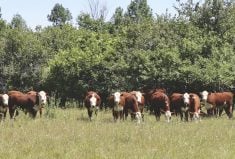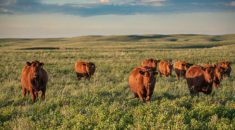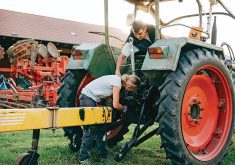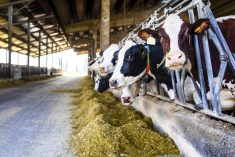Alberta farmers lead the world in reducing greenhouse gas emissions — they just don’t get paid for it, says an expert in the carbon-credit market.
But that’s starting to change, said Jon Alcock, sustainability specialist at Viresco Solutions, a company that develops carbon credits and “carbon intensity scores.”

“On a global scene, Alberta has been a proving ground for lots of other (carbon pricing) systems,” Alcock said at a recent Rural Routes to Climate Solutions event here. “We are the first place globally to demonstrate that we can generate carbon emission reductions from soil carbon. It’s important to note that Alberta has managed to do this when nobody else has managed to do that yet.”
But despite being one of the most developed ecosystem goods and services markets in agriculture today, carbon markets — like the one Alberta implemented in 2007 — haven’t been the payday promised for farmers.
Compliance-based carbon offset credits in Canada are currently around $28 a tonne, which will increase to $40 next year and $50 by 2022.
Read Also

Farming Smarter receives financial boost from Alberta government for potato research
Farming Smarter near Lethbridge got a boost to its research equipment, thanks to the Alberta government’s increase in funding for research associations.
“We know that lots of farmers provide ecosystem goods and services, but we would probably also all agree that most of those services aren’t financially valued enough,” said Alcock.
That’s slowly changing, he added.
Right now, there are essentially two types of carbon markets in Canada — a voluntary one (where companies reduce their emissions of their own volition) and a compliance-based market, where companies are regulated to reduce their emissions. In the latter, those who can’t (or won’t) hit their targets are able to purchase carbon offsets.
“It’s an accounting exercise, effectively,” said Alcock, adding a carbon offset is like any other commodity — “it’s just a thing you can trade for cash.”
These offsets are produced following a protocol that details exactly how the offset will be developed, and offsets can only be generated for activities that already have a protocol. In Alberta, there are 19 active offset protocols, nine of which are applicable to agriculture.
“So if you have some scrub on your land right now, there isn’t a protocol in Alberta that says you can generate carbon offsets from it,” said Alcock.
“It’s an expensive and lengthy process to develop an offset protocol, and there needs to be the funding to do that and the drive from producers to make that protocol happen.”
Supply chain emission reduction
Agricultural protocols are especially tricky, he added.
Generally, protocols are created when a project developer completes the project, collects the data, verifies through a third party that the data is accurate, and then sends the data to the market regulator — in this case, the Alberta government.
But sequestering carbon in soil isn’t permanent, and that’s a challenge.
“If you think about a company that’s switching from incandescent light bulbs to LED light bulbs, that’s an easy thing that’s happened right there and then — there’s no risk of that being reversed, whereas soil sequestration is something that can be reversed,” said Alcock. “Activities can shift, and that’s a risk.”
Because protocols are complicated to produce, they’re costly and so the return on investment is relatively low. That’s why it’s no surprise that farmers aren’t generally being compensated by the carbon market for their efforts,” said Alcock.
But the development of a new type of supply chain-based carbon market could turn that around.
“We’re seeing some really significant movements in the private sector,” he said. “Basically, a company can invest in its supply chain to reduce its Scope 3 (or indirect) emissions. This is really where the opportunity lies for agricultural producers.”
Big-name companies — such as Maple Leaf Foods, Nutrien, and Bayer — have vowed to sharply reduce greenhouse gas emissions in their supply chains, including promoting stewardship on farms. McDonald’s has taken it a step further with its certified sustainable beef framework, and it intends to reach its emission reduction target of 31 per cent from its supply chain by 2030. This will largely come from reduced emissions from beef production.
“They need to reduce upwards of 32 megatonnes of carbon by 2030, and they expect 70 per cent of those emission reductions to come from beef production,” said Alcock.
“McDonald’s needs to meet this target. If it doesn’t meet this target, the negative press is going to be pretty huge. It’s motivated.”
This opens a door for producers, he said.
“Beef producers, you should be seeing dollar signs right now. This is an opportunity.”
Voluntary carbon markets
The quest to become ‘carbon neutral’ means companies — whether making food, selling or creating inputs such as fertilizer — could essentially invest in projects or other activities to reduce emissions and then claim the offset for its supply chain.
That’s already happening elsewhere, said Alcock, pointing to Mars Petcare. The company (a division of the Mars candy and food company) is investing in agronomists and machinery to help wheat growers in Australia farm more sustainably. It then claims emission offsets from those improved production practices.
“This is the way I think this stuff is going,” said Alcock. “It’s probably going to move a little bit away from that traditional market and more into the supply chain. It’s a lot more efficient and has a more direct link to people.”
Voluntary carbon markets are also developing in Canada. Climate Action Reserve has started its first market for Canada, and other voluntary markets are cropping up, albeit slowly.
“For the most part, the protocols are still restrictive enough that it’s not worth generating carbon offsets from them,” Alcock said. “You’ll spend more time trying to develop the project and do the paperwork than would be worth your effort.”
As a result, some groups are looking to transition protocols from the voluntary market to the compliance market. One example is a grasslands conservation project for which a protocol is being tested for the compliance market.
“In the voluntary market, you’re looking at somewhere between $3 and $7 per offset. In Alberta, we’re looking at closer to $30 per offset,” said Alcock.
“So one of our biggest aims is to try and get this approved in the Alberta compliance market this year. That way, for the same project, you could get five times the cash for the same offset.”
His company is also working on a grassland restoration protocol, which involves converting cropland back into grassland.
“This is a big topic right now. Lots of people have just started working on this in the last year or two,” said Alcock, adding a protocol was submitted to the province in 2013. “Now everyone is clamouring for this, so we’re going to be trying to get that approved this year as well.”
But farmers also have a role to play in this, he added.
If carbon is a commodity like any other and farmers hope to make a profit from it, they’ll need to get more engaged in building its markets.
“We don’t want this stuff to develop top down as it has been in the past. We need to have producers telling us, ‘This is or isn’t going to work on our farm,’” said Alcock.
“Farmers really have an opportunity to make something of this, so it’s critical at this point that producers get engaged in this process.”















